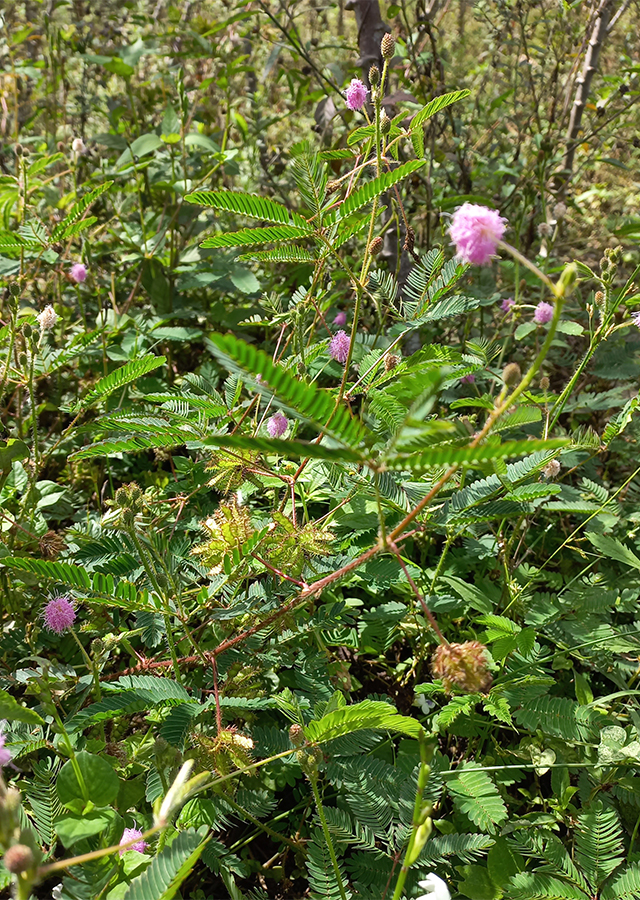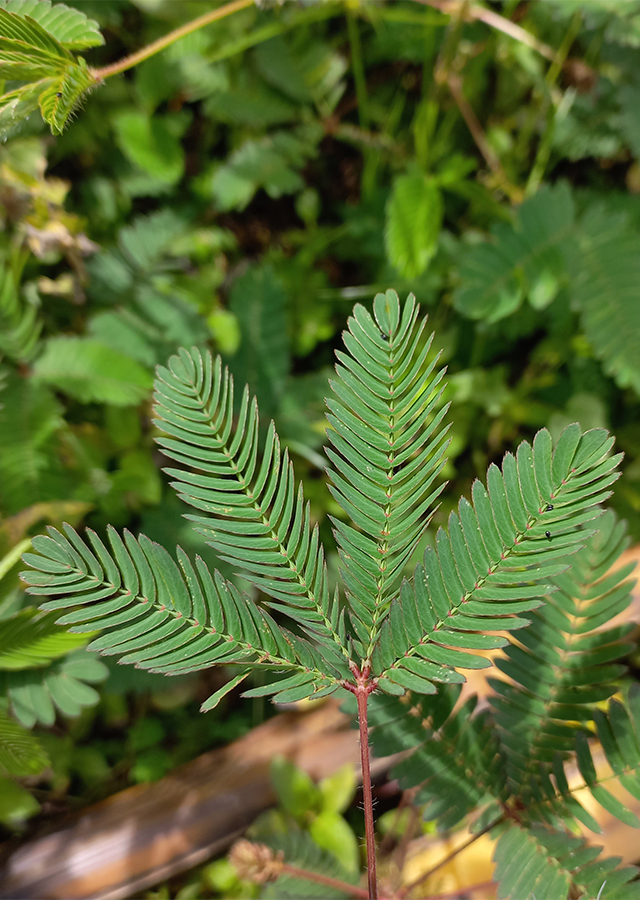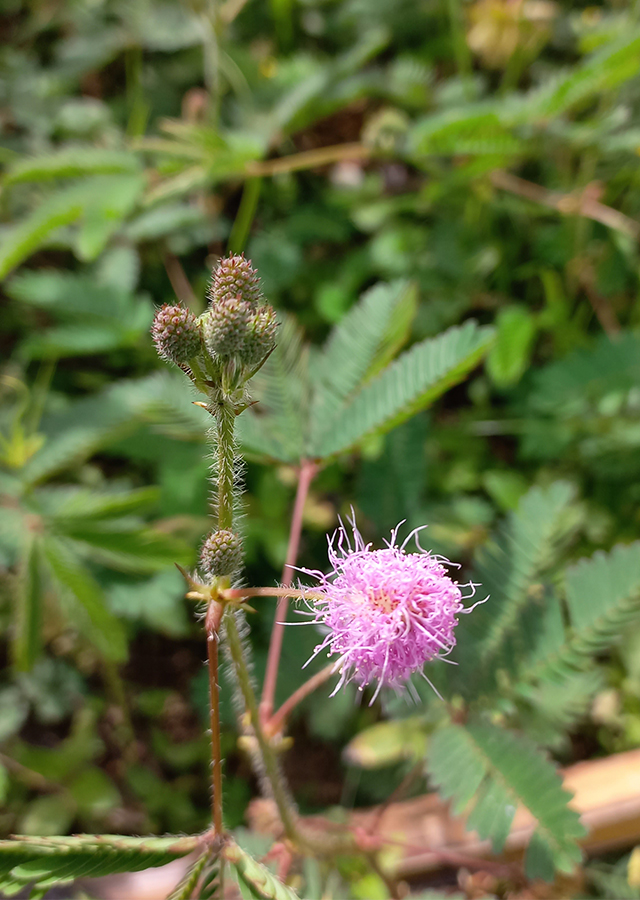Traditional Herbs from Mimosa pudica
insomnia_difficulty_sleeping
- Prepare 30-60 g of the leaves of the big mole princess.
- Wash until clean then boil.
- Strain the boiled product.
- Drink.
skin_inflammation_festering
- Take fresh plants big embarrassed princess then wash it clean.
- Crush it until it becomes a paste.
- Put the paste on the sore and festering part of the skin.
What is Mimosa pudica Looks like??



Parts of Mimosa pudica that could be used
- Leaves", "Roots", "Stems", "All Parts of the Plant
Mimosa pudica Distribution
Mimosa pudica is a sensitive plant originating from South America, and has spread widely and become a serious weed throughout tropical regions of the world. However, the weed plant can be grown as a cover crop or green manure and has been identified as having potential for phytoremediation of arsenic-contaminated areas in Thailand. Sometimes, Mimosa pudica can also be grown as an ornamental plant. In Guadeloupe, Trinidad and Tobago, Cuba, Brazil, India, Malaysia, and the Philippines, Mimosa pudica is an important source of pollen for the Italian honey bee (Apis mellifera) and other bees. Apart from that, Mimosa pudica has good health benefits and has been used as an ingredient in traditional medicine in various countries. In Indonesia, Malaysia, and Thailand, this plant is used to treat insomnia and as a poultice to treat swelling. In South America it is considered an emetic and is also used to treat diarrhea and dysentery. In Ayurvedic medicine, this plant is used as an antiasthmatic, aphrodisiac, analgesic, and antidepressant.Agroecology of Mimosa pudica
Mimosa pudica is usually found growing along roadsides, empty lots, grasslands, in rubbish bins, disturbed areas in many tropical areas, from sea level to a height of about 1,300 m above sea level. This plant can also grow in various types of soil, including soil with low fertility, is able to tolerate waterlogging and is resistant to drought, and the degree of soil acidity (pH) is in the range of 6-7 and tolerates 5-7.5. Prefers a position with full sun (about 6-8 hours per day), but is not shade tolerant. Able to grow well in areas with average annual rainfall in the range of 1,000 - 2,000 mm, annual daytime temperatures are in the range of 22 - 28 °C, but can tolerate 10 - 32 °C.
Morphology of Mimosa pudica
- The taproot is yellowish white, long, strong. It has a distinctive odor that resembles jengkol fruit.
- Cylindrical stem, many branches, hairy, thorny along the joints, woody at the base, reddish brown or purple. The spines are long about 3-4 mm, dense, slightly curved, hard and very sharp.
- Leaves are compound, bipinnate, each leaf is composed of 15-20 pairs of leaflets, the leaves are alternate, colored dark green, hairy, linear oval shape, flat edges. If touched, the leaves will quickly close (sensitive) and also close at night.
- The flowers are round like a pompom, composed of hundreds of thin petals like a crown, purplish pink with the four stamens are prominent. The petals are small and the corolla is four-lobed and about 2 mm long. The stalk is 12-25 mm long, emerging from the leaf axil, densely hairy and bearing clusters of flowers (5-8 flowers are found in the leaf axils).
- Flat oval pods, curved, spiny edges, contain 1-5 seeds, green and turn brown when ripe.
- Seeds are light brown, flat, 2.5-3 in diameter mm and fine granular surface.
Cultivation of Mimosa pudica
- Propagation is carried out generatively using seeds.
- Before sowing, soak the seeds for 12-24 hours in warm water to speed up germination.
Mimosa pudica, more details :
Chemical Content of Mimosa pudicaC-glycosylflavones (2-O-rhamnosyl-orientin and 2-O-rhamnosyl-isoorientin), mimosine (N-(3-alanyl)-3-hydroxy-4-pyridone), flavonoids, phytosterols, alkaloids, amino acids, tannins , glycosides, tubulin, crocetin dimethyl ester, turgorine, terpenoids, quinines, phenols, saponins, coumarins, cardiac glycosides, coumarin glycosides.
Benefits of Mimosa pudica
Treats insomnia, seizures, diarrhea, dysentery, tumors, wound healing, bruises, snakebites, cancer treatment, diabetes, hepatitis, hemorrhoids, jaundice, hypertension, obesity, urinary tract infections, boils, smallpox, arthritis, swelling, relieves asthma , expectorant, sore throat and hoarse voice, mouthwash to reduce toothache, emetic, antidepressant, diuretic, aphrodisiac, antihelminthic, antioxidant and immunomodulator.
Simplisia of Mimosa pudica
Another Facts for Mimosa pudica :
Synonym of Mimosa pudicaEburnax pudica (L.) Raf.
Habitus of Mimosa pudica
Herb. Annual or annual herb, grows creeping, up to 100 cm high
Habitat of Mimosa pudica
- Riverside", "Forest", "Coast", "Roadside", "Grassland", "Land
No comments:
Post a Comment